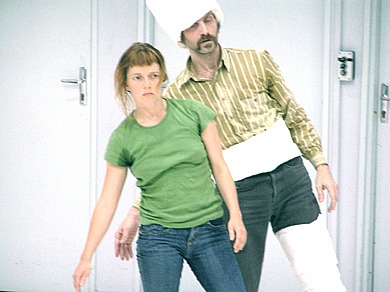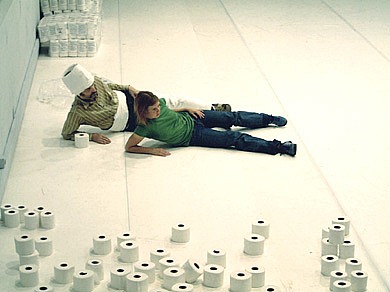2009 Tüdeldüddel-Lüd
2009 Gangplank
2006 Still Lives Installation
2005 Leistung
2005 White Trash
2005 Still Lives
2004 Revolver
2004 California Roll
White Trash

Concept
Broadly articulating the concepts and ideas for this work circle around human and societal relationships between indifference: i.e., separation with the world and its events and states of impassiveness: i.e., to the world and its events. The performance seeks to create references to society that is ultimately formed by it and is about it – but is radically opposed to it by not offering any sensationalism in showing it. Instead the performance seeks to work in the microcosm of care and responsibility to one’s immediate surroundings as against world care which is so often ascribed to projections rather than probable realisations.
Read more
Another case of an existing oppositional dialectic is the dilemma of neutrality. For example: the white neutral room is to all intensive purposes a construction of a dominant mind-set. The white neutral room has been invented for how one is asked to perceive neutrality as the dominant vision where differences, it can be asserted, can disappear. Both of these examples are flawed.
White Trash brings together the association of the above flaws by taking them into the work. Dealing with the above oppositions i.e., disappearance, vision and neutrality and one’s ability to deliver care is to take part within these constructions and yet acknowledge the participation within these existing dominant mind-sets. But not all minds, not all carer’s and certainly not all bodies come to be fielded within this dominant construct. white trash gambles with these dialectics within a white space. This space, a container, sucks and absorbs hides and deletes other histories, other realities through its pretence for neutrality.
performance aspects
One aspect of the work is to take direct action of the above dominant modes of thought and action into the performance event. Part of the performance is an action of wrapping the body which participates to both the first aid on the body and its disappearance. Through creating casts on parts of the body the performance addresses the care of oneself that which is a universal body experience. This experience comes in the form of a slow and gradual transformation of two bodies assimilating into the white environment.
Taking care and covering wounds is the first action towards stepping outside of oneself towards taking care for others. Two people, who are not the same as each other, begin through care of the self to create the opportunity of vanishing to join what the dominant mind-set hides. Disappearing within the constructed white environment opens the opportunity to delve behind that environment and address what it covers.
The aim of this work then is to collectively position the spectator into different fields of separation and connection – between hearing and seeing, between visual recognition and appearance, between conflict of performance expectation and performance experiencing, between gaining a hold on the work and getting something from it, between consuming it and dismissing it, between being filled by it and emptied by it. The work is not about telling the audience something, anything or discharging value but does seek to find other ways in how the above senses can be stimulated and finally reassembled during the performance as part of a collective audience experience.
Incorporating basics constructs such as care separation and expectation are enacted. Through the fragility and allegory of paper the performers wrap and discard themselves ‘out of appearance’. The point to come too is the erasure of expectancy.
A Performance by Ben Anderson, Benoit Lachambre, Bruno Pocheron and Isabelle Schad
Concept / realisation: Ben Anderson, Benoit Lachambre, Bruno Pocheron, Isabelle Schad
Choreography / performance: Benoît Lachambre, Isabelle Schad
Lighting / soundtrack: Bruno Pocheron
Dramaturgy / video: Ben Anderson
Text animations: Ben Anderson, Bruno Pocheron
Production: Good Work Productions
Co-production: Printemps de Septembre / CDC, Toulouse
Espace Pier Paolo Pasolini, Valenciennes
Thanks to: par b.l. eux, Tanzwerkstatt Berlin
This specific formulation of the credits has to be respected by any venue presenting white trash in any published document.
White Trash Avant-Premiere in CDC Toulouse.
Premiere in l’Espace Pier Paolo Pasolini in Valenciennes November 2004.








2006 White Trash in Radialsystem, Berlin
10th / 11th December 2006
Presented in the context of Tanz Made in Berlin
in Radialsystem V, Holzmarktstr.33 10243 Berlin
See online: Tanz made in Berlin
2006 White Trash at Ballet-Teatro, Porto
The next presentation of this collaborative piece will be at Ballet-Teatro in Porto on the 10th of June 2006
2005 White Trash in DanceKiosk, Hamburg
16th July 2005 at 20:30
Kiosk.ShotCuts Performances
in Sprechwerk, Klaus-Groth-Straße 23
20535 Hamburg
2005 White Trash in Tanzquartier Wien
30th March 2005 in Halle G. Museumsplatz 1, 1070 Wien.
See online: Tanzquartier Wien
This technical rider will be adapted to each venue. An appropriate sound and light plot will be worked out on plans.
Contact: Bruno Pocheron
![]() White Trash Light and Sound plot.pdf
White Trash Light and Sound plot.pdf
STAGE
– minimum 12 m by 12 m.
– white dance floor.
– white box (solid walls are better, white cycloramas on three sides are possible if we find a way to stretch them very well).
– toilet paper (Tork 4 layers, white, no perfume): 20 packages of each 10 times 6 rolls.
– 3 white chairs (we bring).
– 10 rolls of white medical tape.
LIGHTS
– 20 asymmetric floods 1 kw in lee 711 + lee 251 / 10 channels @ 2 kw.
– 30 asymmetric floods 1 kw in lee 061 + lee 251 / 15 channels @ 2 kw.
– 16 profiles 1 kw in lee 061 + rosco 119 / 8 channels @ 2 kw.
SOUND
– 1 cd player / 1 stereo line.
– we bring 1 computer with fire wire sound card / 4 stereo lines.
– 2 full range speakers in the back of the stage / 1 amp.
– 2 full range speakers in the front of the stage / 1 amp.
– 2 full range speakers in the back of the audience / 1 amp.
– 2 subwoofers / 1 amp.
– 1 mixboard / minimum 5 stereo in / 4 independent stereo outputs / each stereo line in should have the possibility to be played on the 4 stereo outputs.
VIDEO
– projection on the whole surface of the white back wall.
– 1 video projector minimum 3500 ansi Lumen, with wide angle lens, lens shift possibility, wired remote control and hanging system. the idea is to get the full back wall, either in ceiling front projection, with the smallest possible distance between projector and wall to avoid shadows of the performers on the wall, or in back projection if possible.
– we bring a wireless shutter system (radio controlled).
– 1 DVD player.
– a very small video monitor (black and white is also ok).
Im Selbstversuch zum Nullpunkt
Unendlich langsam bewegt sich das Paar durch die weiß ausgeschlagene, in alle Winkel ausgeleuchtete Bühnenbox. Ein Ort, der aus Raum und Zeit gefallen scheint. Und ob die beiden ein Paar sind, weiß man auch nicht so genau, bis deutlich wird, wie ausweglos sie aneinander kleben, wie Teilchen in einem magnetischen Feld, gesteuert von Kräften, die sie nicht kontrollieren können, die dennoch Teil ihrer selbst sind.
“White Trash” nennen Benoît Lachambre und Isabelle Schad ihre choreografische Versuchsanordnung, die die beiden Tänzer und Choreografen zusammen mit dem Licht- und Sounddesigner Bruno Pocheron und dem Videokünstler Ben Andersen entwickelt haben.
Read more
Am Rand türmen sich Rollen von weißem Klopapier, Teile ihrer Körper beginnen die Darsteller darin einzuwickeln. Sie umhüllt ihr Bein, er sogar den Kopf, bis ein gigantischer Turban auf seinen Schultern thront. Seltsam beschädigt sehen die beiden aus. Als sei ihr Körper eine offene Wunde, die gegen außen geschützt werden muss.
Doch je mehr man sich auch abschirmt, desto lauter werden die inneren Geräusche, der Atem, das Knistern des Papiers, das Knarzen der Stühle, auf denen sie sitzen, die verstärkt aus den Lautsprechern dringen. Und dann herrscht Totenstille, das Licht verdunkelt sich und über die Rückwand läuft ein Film, streift eine Kamera durch Räume, die an Labore oder Büroräume erinnern.
Nüchtern betrachtet reduzieren die Berlinerin Schad und der Kanadier Lachambre, zwei versierte und erfahrene Performer, ihre Inszenierung auf eine Begegnung zweier Individuen im Spannungsfeld des sozialen Mikrokosmos einer Tanzbühne. Mit dem Ziel, eine Art Nullpunkt anzupeilen, an dem ihre Absichten sich verwischen, die Erwartungen sich neu ordnen. Letztlich ist es ein Selbstversuch, mit dem der zeitgenössische Tanz seine Strategien von Kommunikation immer wieder gern erprobt, in Frage stellt und weiterentwickelt. Ihr praktizierter Reizentzug stellte die Zuschauer auf eine Geduldsprobe.
Doch irgendwann entfaltet diese Reise durch innere Denk- und Sinnesräume einen tranceartigen Sog, dem man sich kaum mehr entziehen kann.
Marga Wolff
taz Hamburg Nr. 7718 vom 18.7.2005, Seite 22, 89 Kommentar Marga Wolff, Rezension
Aftershow
Printemps de septembre à Toulouse, du 24 septembre au 17 octobre
Si, comme l’a clamé Philippe Soupault, «toutes les saisons sont cruelles», le Printemps de septembre se montre plutôt tendre à l’égard des Toulousains, qui, durant près d’un mois, se voient offrir une belle brassée d’expositions et de gâteries scéniques. Printemps tardif ou pas, qui dit gâterie ne dit pas forcément régalade… Voilà une triste évidence que ne contesteront pas ceux sur lesquels Ed Kuepper a déversé son (abo)minable brouet sonore, sur fond d’images souvent ineptes, ou ceux qu’aura sévèrement barbé le récital mou du scalp des squaws de Coco Rosie. Pour aider à digérer tout ça, rien de tel que le blip-hop foutraque du toujours intenable Jamie Lidell, performer hors pair qui se mue, au choix, en human beatbox détraquée ou en crooner déjeté tandis que son compère Pablo Fiasco (sic) bidouille un vidéo-mix ad hoc. Dans un registre beaucoup plus calme, Transat, l’ingénieuse installation sonore de Boris Billier proposant à chaque visiteur, étendu dans un transat et muni d’un casque et de lunettes opaques, d’écouter une courte pièce de musique contemporaine (composée par Billier) ménageait une parfaite plage de régénération. De son côté, nlf3 a, le temps d’un ciné-concert splendide, fait forte impression : au moyen d’un score aussi fluide que nuancé, ce groupe français (trop) peu connu réussit la prouesse de rehausser encore l’éclat du Que viva Mexico! d’Eisenstein. D’une ampleur moindre, En privé à Babylone, première mise en scène de la danseuse Hélène Iratchet a néanmoins séduit par sa maladresse même et par sa fidélité à l’esprit du plus japonais des écrivains américains, le zenial Richard Brautigan. Finissons par l’éloge de Benoît Lachambre et Isabelle Schad, chorégraphes et interprètes de White trash, fascinante œuvre au blanc dont l’irréductible étrangeté procède de la rencontre rêvée entre burlesque minimal et lenteur maximale : quelle neige ne fondrait devant pareil spectacle?
Jérôme Provençal / Les Inrrockuptibles